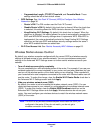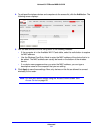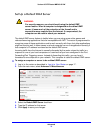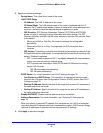
Advanced
68
Verizon 4G LTE Router MBR1515LVW
2. Your IRC client composes a request message to an IRC server using a destination port
number of 6667, the standard port number for an IRC server process. Your computer then
sends this request message to your router.
3. Y
our router creates an entry in its internal session table describing this communication
session between your computer and the IRC server. Your router stores the original
information, performs Network Address Translation (NAT) on the source address and port,
and sends this request message through the Internet to the IRC server.
4. Noting
your port triggering rule and having observed the destination port number of 6667,
your router creates an additional session entry to send any incoming port 113 traffic to your
computer.
5. Th
e IRC server sends a return message to your router using the NAT-assigned source port
(as in the previous example, say port 33333) as the destination port. The IRC server also
sends an identify message to your router with destination port 113.
6. Upon receiving the
incoming message to destination port 33333, your router checks its
session table to determine whether an active session for port number 33333 exists. Finding
an active session, the router restores the original address information that is replaced by
NAT and sends this reply message to your computer.
7. Upon receiving the incoming
message to destination port 113, your router checks its session
table and learns that an active session for port 113 exists and is associated with your
computer. The router replaces the destination IP address of the message with the IP
address of your computer and forwards the message to your computer.
8. Wh
en you finish your chat session, your router eventually senses a period of inactivity in the
communications. The router then removes the session information from its session table,
and incoming traffic is no longer accepted on ports 33333 or 113.
To configure port triggering, you need to know which inbound ports the application needs.
Also, you need to know the number of the outbound port that triggers the opening of the
inbound ports. You can usually determine this information by contacting the publisher of the
application or user groups or newsgroups.
Note: Only one computer at a time can use the triggered application.
Port Forwarding to Permit External Host Communications
In both of the preceding examples, your computer initiates an application session with a
server computer on the Internet. However, you need to allow a client computer on the Internet
to initiate a connection to a server computer on your network. Normally, your router ignores
any inbound traffic that is not a response to your own outbound traffic. You can configure
exceptions to this default rule by using the port forwarding feature.
A typical application of port forwarding can be shown by reversing the client-server
relationship from the previous web server example. In this case, a browser on a remote
computer accesses a web server running on a computer in your local network. Using port
forwarding, you can tell the router, “When you receive incoming traffic on port 80 (the
standard port number for a web server process), forward it to the local computer at


















